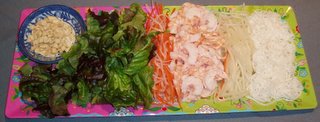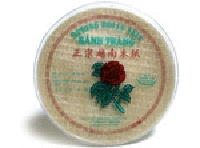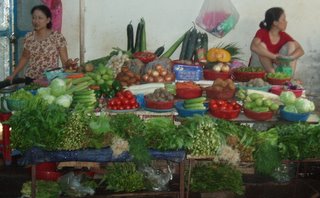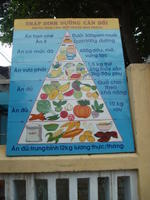 Somehow the winter weather has made me long for a taste of spring. What better way than with a fresh Vietnamese-style spring or salad roll, filled with healthy greens, fragrant herbs, crunchy vegetables and moist tofu, shrimp and/or fruit. Since these rolls are mostly vegetable and eaten fresh without frying they are naturally low in fat and calories.
Somehow the winter weather has made me long for a taste of spring. What better way than with a fresh Vietnamese-style spring or salad roll, filled with healthy greens, fragrant herbs, crunchy vegetables and moist tofu, shrimp and/or fruit. Since these rolls are mostly vegetable and eaten fresh without frying they are naturally low in fat and calories.Forming the rolls is not that hard after you practice with one or two, and even if your handiwork is a bit messy, all the tastes still combine wonderfully in your mouth. Hey, you deserve a spring break, even if it is winter.
Don’t be intimidated by the list of ingredients. I’ve given you a lot of options and you aren’t supposed to make them all. Here in the San Francisco Bay area we have lots of Asian markets so everything is pretty easy to get, but most of the ingredients can be bought at a good supermarket or gourmet store. I suggest alternatives to anything that might be truly exotic or hard-to-find and list web resources at the end of the post. Most of the work for this dish is in the shopping, especially if you serve them as we do. We tend to put out piles of the ingredients and either encourage everyone to wrap his or her own or my husband, Gary, assembles them to order. It’s a great dish for entertaining. The photo above was taken at a recent dinner with friends and shows the ingredients ready to wrap and roll.
While we ate spring rolls throughout our recent trip to Vietnam, we never quite had any like this, but the ingredients did vary. The fresh ones were very refreshing in the hot, steamy weather of Hanoi. Some spring rolls we saw or ate had cooked pork, chicken or mushrooms in them. Often they are fried. (One memorable version in Hue was filled with meat, fried, sliced into small pieces on the diagonal, speared with toothpicks and stuck decoratively in a pineapple in a way that resembled a peacock’s tail. It was quite spectacular and made me truly sorry that my camera battery was dead. The fact that it appeared that the pineapple itself was reused in the display for the next customer did not dim its charm.)
Not Quite Spring Rolls
Serves 8 as an appetizer, 2 rolls a piece
Part A – the Main Filling - Choose One or More of the Following:
16 medium to large shrimp, cooked, peeled and deveined, sliced in half vertically, so you have 32 flat halves. Drain well and pat dry.
4 ounces of firm tofu, cut into matchstick-size pieces, patted dry and sautéed or stir fried in a tablespoon of oil until just golden. Splash with a teaspoon or two of soy sauce and stir until the tofu pieces are coated with the soy sauce. Remove from the pan and drain well. Mix cooked tofu pieces with 1 teaspoon very finely minced lemon or lime zest.
4 ounces fresh, ripe, peeled and seeded (but still firm) mango or papaya, cut into matchstick-size pieces and drained.
Peeled, seeded, cucumber cut into matchstick-size pieces. Place on paper towels and allow to drain. Pat dry before using.
Part B – Rice Stick Noodles and Other Shredded Things -- Offer the Rice Stick Noodles and One or More of the Following for a Total of Four Cups or More
Prepared rice stick noodles or “bun,” rinsed in water, drained well, cooled. (These are dried, very thin rice noodles that are available in Asian markets and some supermarkets. Sometimes called rice vermicelli. Be sure to buy the very thin noodles made from rice or rice flour and not mung beans or wheat flour. Careful not to get the thin “banh pho” rice stick noodles, which are flat noodles for soups and look like linguini.) To prepare, cook about 4 ounces in boiling water for about five minutes.
Rinsed, cleaned fresh mung bean or other sprouts, well drained
Cooked, cooled, spaghetti squash, separated into noodle-like strands (very untraditional but adds a nice flavor, crunch and nutrient boost)
Finely shredded green papaya. Green papaya is not unripe regular papaya. It is a separate variety of the fruit that is eaten like a vegetable. It is available in many Asian specialty markets. It adds a bit of taste and a lot of texture to the spring rolls.
Finely shredded carrots
Finely shredded daikon radish or jicama. Daikon radish is long and white and on the mild side. Jicama works fine if the radish isn’t available. Or try finely shredded turnip for a more peppery taste.
(Note: Some Asian markets sell fresh pre-shredded green papaya and a mix of pre-shredded carrots and radishes in the produce section.)
Part C- Herbs and Greens – Use One Cup of FRESH Herbs to Go with the Lettuce for a Total of Two Cups Herbs and Greens
One cup shredded red or other soft, leaf lettuce (should be bite size pieces)
Plus One Cup of a Combination of the following:
Asian or Thai basil, chopped or shredded without stems. Sometimes called anise basil. (Do not substitute Italian style basil)
Mint, chopped or shredded without stems
Cilantro, chopped or shredded with harder stems removed
Vietnamese herbs (available in some Asian stores) such as “ngo gai,” saw-leaf herb (a member of the cilantro family), “rau ram” (Vietnamese coriander), and many others. Chopped or shredded with harder stems removed
Part D – Sauce -- Pick One or Both, You’ll Need a Little More than a ¼ Cup Total
Prepared Hoisin Sauce (buy a good quality one)
Peanut - Hoisin Sauce mixed one part hoisin sauce, one part good quality smooth peanut butter. Stir. Add hot water by the teaspoonful and keep stirring until mixture is smooth and well combined. Optional, add a splash of Vietnamese or Thai Fish Sauce (see note below in dipping sauce segment) or soy sauce.
Part E – Wrappers -- Pick One or Do Some of Both

16 (plus extras for the learning curve) Vietnamese dried round rice paper wrappers for spring or salad rolls (“banh trang”). Be sure you get wrappers made from rice not wheat flour. The size of these round wrappers seems to be very consistent between brands.
16 red lettuce, butter lettuce or other soft leaf lettuce leaves, washed, drained and patted dry (plus extras for the learning curve)
Use the lettuce leaves if you can’t get the wrappers. Wrapping ingredients like this in a lettuce leaf is not uncommon in Vietnam and is usually referred to as a salad roll. Obviously, if you are making some of each, you'll need only need 16+ total for both.
Part F – Dipping Sauce & Garnish
Nuoc Cham – Spicy Dipping Sauce
1 clove garlic, peeled and very finely minced
2-3 small hot red fresh Thai (bird) or Serrano chiles. (Remove seeds if you want a less hot sauce), very finely minced. (If it’s all you can get, use fresh jalapenos)
1 tablespoon plain, unseasoned rice vinegar
Juice of one lime
2 tablespoons sugar
¼ cup water
Tablespoon of mixed finely shredded carrot and daikon, chopped
One tablespoon Vietnamese or Thai Fish Sauce (See Note.)
Combine all ingredients and mix well. Put out in small bowls for dipping.

Note: In the photo at left are different kinds of Vietnamese fish sauces (“nuoc mam”) on display at the kitchen of a hotel in Hanoi. The nuoc mam that is imported to the U.S. is most often made with anchovies. The sauce adds an indefinable boost to many Vietnamese foods and sauces. Thai fish sauce (‘nam pla”) is an acceptable substitute. If neither is available or if you are making strictly vegetarian food, substitute a combination of unseasoned white rice vinegar and soy sauce, maybe even mushroom soy sauce. I have seen Thai fish sauce in many supermarkets and both are available in Asian markets.
For a mouth watering discussion on why fish sauce seems funky but can be addictive, please read Orangette's musings.
Garnish -- ¼ cup roasted peanuts (not salted), chopped.
Assembly
At last, after all that shopping and chopping and shredding – here’s the pay off, you get to eat these rolls and customize them to your specifications.
Set out all of your choices from Parts A through D plus the peanuts. Put dipping sauce into conveniently placed bowls.
Prep rice paper wrappers. Have a flat, open container for some hot water, big enough to submerge a wrapper in without folding or bending. Submerge wrapper long enough for it to soften. Timing will depend on brand, temperature of the water and atmospheric conditions. Wrapper will emerge very soft and pliable. Place wrapper on cotton towel. It is ready to fill and roll.
If your softening of the wrappers gets ahead of the rolling, cover softened wrappers with a damp cotton towel. Don’t let wrappers sit too long.
To fill, place wrapper round in front of you. All the action is going to happen on the bottom third of the round. Start by dabbing a half teaspoon to teaspoon of either the hoisin or peanut-hoisin sauce in the middle of that bottom third section. Select your greens, herbs, shredded vegetables, shrimp, etc and place in that bottom third, leaving about an inch margin on both sides and the bottom. Top off with a sprinkling of the chopped peanuts.
Fold up 1” margin from the bottom over filling and then fold 1” margin on the sides of wrapper towards the middle over filling. Roll bottom third over towards middle and then roll again, using your fingers to help compress the roll. It is like rolling a burrito. (For another take on a Spring Roll Recipe and for step by step photos of how to wrap, click here from this article from Digs Magazine.)
If you are using lettuce leaves, fill and roll them in a similar manner.
Don’t worry if your first rolls are loose or messy. They will taste just as good.
Dip the finished roll into the dipping sauce and eat.
Leftovers? -- Cut the rice noodles into 2 inch lengths and combine ingredients from Parts A, B and C and chopped roasted peanuts into a salad, adding more lettuce if needed. Thin dipping sauce out with a bit more vinegar and a few tablespoons of grapeseed or other vegetable oil and toss with salad.
------------------------------
Some resources:
Mai Pham's growing empire of things Vietnamese is a great informational resource.
There are many resources for buying Vietnamese ingredients on the web. For research purposes I checked availability from Ethnic Grocer, which also provided the spring roll wrapper photo.
While it is more of a supermarket than a charming specialty store and many of their Vietnamese selections are limited, the Ranch 99 chain of markets has all the Asian ingredients needed for this recipe, although it does not offer mail order. Ranch 99 has locations on the West Coast and Arizona.
Thai basil, bird chiles and other fresh produce are available from Import Food by mail order.
This write up is part of Sweetnicks Tuesday round up of antioxidant rich food recipes (ARF). Please check out her complete list of participants. Sweetnicks also hosts the popular Weekend Dog Blogging Photo event. This should be her year since this is the Year of the Dog.
Yep, we are in the middle of celebrating the Lunar New Year and these spring rolls are also my way of honoring the event. For more information on the traditions and meanings of the Lunar New Year, check out The Hungry Rose
Vietnamese Food







